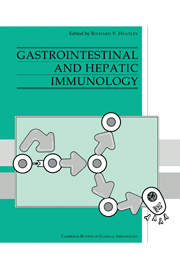Book contents
- Frontmatter
- Contents
- List of contributors
- Preface
- 1 Lymphoid cells and tissues of the gastrointestinal tract
- 2 Lymphocyte migration to the gut mucosa
- 3 Regulating factors affecting gut mucosal defence
- 4 Gastritis
- 5 The immunology of coeliac disease
- 6 Inflammatory bowel disease
- 7 Food intolerance and allergy
- 8 Gastrointestinal and liver involvement in primary immunodeficiency
- 9 Secondary immunodeficiency – the acquired immunodeficiency syndrome (AIDS)
- 10 Intestinal infections
- 11 Lymphomas
- 12 Small bowel transplantation
- 13 Clinical aspects of immunologically mediated intestinal diseases
- 14 Chronic active hepatitis
- 15 Primary biliary cirrhosis
- 16 Immunology and immunopathology of acute viral hepatitis
- 17 Immunology of liver transplantation
- 18 Clinical correlates with hepatic diseases
- Index
12 - Small bowel transplantation
Published online by Cambridge University Press: 03 February 2010
- Frontmatter
- Contents
- List of contributors
- Preface
- 1 Lymphoid cells and tissues of the gastrointestinal tract
- 2 Lymphocyte migration to the gut mucosa
- 3 Regulating factors affecting gut mucosal defence
- 4 Gastritis
- 5 The immunology of coeliac disease
- 6 Inflammatory bowel disease
- 7 Food intolerance and allergy
- 8 Gastrointestinal and liver involvement in primary immunodeficiency
- 9 Secondary immunodeficiency – the acquired immunodeficiency syndrome (AIDS)
- 10 Intestinal infections
- 11 Lymphomas
- 12 Small bowel transplantation
- 13 Clinical aspects of immunologically mediated intestinal diseases
- 14 Chronic active hepatitis
- 15 Primary biliary cirrhosis
- 16 Immunology and immunopathology of acute viral hepatitis
- 17 Immunology of liver transplantation
- 18 Clinical correlates with hepatic diseases
- Index
Summary
Introduction
With the development of immunosuppressive drugs in the late 1950s there was interest in the possibility of all forms of organ transplantation. Early experiments on small bowel transplantation were undertaken by Lillehei in Minneapolis. He was able to demonstrate from experiments in dogs that transplantation of the intestine was technically possible (Lillehei, Goott & Miller, 1959). However, rejection was intense and with the combination of azathioprine and steroids, even modest prolongation of graft survival could not be achieved. His work also indicated that, unlike other forms of organ graft, the small bowel had the potential to cause graft-versus-host disease (GvHD). During the 1960s and 1970s a small number of human intestinal transplants were performed in desperate cases. With the exception of one patient who survived for over two months (Fortner et al., 1972), the remaining individuals all died within days of the operation (Lillehei et al., 1967; Okumura, Fujimari & Ferrari; 1969; Olivier et al., 1969; Alican et al., 1971). In some cases, histology of the graft did not show severe destructive changes from rejection, and it is now clear that these patients died from sepsis as a result of bacterial translocation across the gut lumen to the blood stream. The advent of cyclosporin in the 1980s rekindled interest in small bowel transplantation leading to clinical programmes in both Europe and North America.
Graft physiology
A transplanted segment of small bowel is, of necessity, denervated and deprived of normal lymphatic drainage. The lack of autonomic control leads to an initial hypersecretion from the crypts.
- Type
- Chapter
- Information
- Gastrointestinal and Hepatic Immunology , pp. 235 - 246Publisher: Cambridge University PressPrint publication year: 1994



